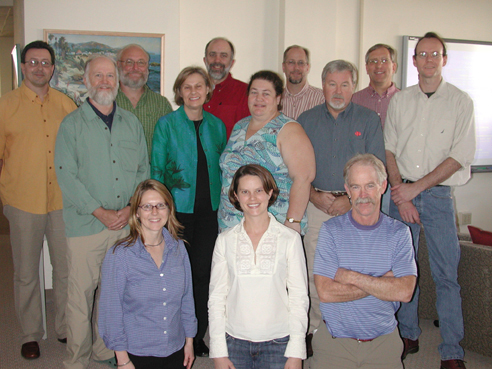NCEAS Working Groups
Global trajectories of seagrasses: Establishing a quantitative basis for seagrass conservation and restoration
Project Description
Seagrasses are a group of flowering plants that have evolved a unique set of characteristics to live, grow, and reproduce in marine underwater habitats (Les et al., 1997), with key ecosystem services that they provide to coastal areas of the world (Costanza et al., 1997). During the past two decades there has been a significant increase in the number of studies on the distribution, abundance, biology and ecology of seagrasses, including the recent publication of a seagrass atlas (Green and Short, 2003); methods book (Short and Coles, 2001) and research synthesis (Larkum et al., in press). However, the need for a better understanding of seagrasses today has taken on a new meaning and increased urgency. The rate of ecosystem alteration in coastal regions where seagrasses reside is accelerating (Cohen et al., 1997), and these alterations are occurring globally (Short and Wyllie-Echeverria, 1996). The very survival of seagrasses, which have been present for the past 100 million years, depends on their ability to cope with these natural and anthropogenic alterations. The goal of the ¿Global Seagrass Trajectories¿ working group, and the designated sub-groups, will be to use quantitative approaches to critically evaluate the types of changes that seagrasses are experiencing and evaluate likely causes. A previous qualitative examination of the literature indicates that seagrasses are experiencing loss rates (Green and Short, 2003) which match or exceed those of other threatened coastal habitats, such as salt marshes, mangrove forests, and coral reefs (e.g., Pandolfi et al., 2003), for which there is ample scientific and social awareness. Yet, a global assessment with quantitative data for seagrasses is lacking and is the focus of this effort. Synthesizing available information and conveying them to the broader scientific community and society in an effective way will be a key outcome of this project.

Principal Investigator(s)
Robert J. Orth, William C. Dennison
Project Dates
Start: August 1, 2005
End: December 31, 2007
completed
Participants
- Tim J. Carruthers
- University of Maryland Center for Environmental Science
- William C. Dennison
- University of Maryland Center for Environmental Science
- Carlos M. Duarte
- Instituto Mediterraneo de Estudios Avanzados
- James W. Fourqurean
- Florida International University
- Kenneth L. Heck
- Dauphin Island Sea Laboratory
- A. (Anne) Randall Hughes
- University of California, Davis
- Gary A. Kendrick
- University of Western Australia
- W. Judson Kenworthy
- National Oceanic and Atmospheric Administration (NOAA)
- Suzanne R. Livingstone
- Old Dominion University
- Suzanne Olyarnik
- University of California, Davis
- Robert J. Orth
- Virginia Institute of Marine Science
- Frederick T. Short
- University of New Hampshire
- Michelle Waycott
- James Cook University
- Susan L. Williams
- University of California, Davis
Products
-
Presentations / 2006
A global crisis for seagrass ecosystems
-
Presentations / 2007
Could climate change and eutrophication promote Ruppia as the seagrass of the future
-
Journal Article / 2007
Seagrasses of south-west Australia: A conceptual synthesis of the world's most diverse and extensive seagrass meadows
-
Presentations / 2009
Global trajectories of seagrasses: Understanding multi-decadal seagrass change in relation to species, regions, habitats, and processes of change
-
Presentations / 2007
Global trajectories of seagrasses: A quantitative assessment
-
Presentations / 2009
Closing the charisma gap: How to integrate seagrasses into the public dialogue on coastal ecosystems
-
Book Chapter / 2009
Global trajectories of seagrasses, the biological sentinels of coastal ecosystems
-
Journal Article / 2008
The charisma of coastal ecosystems: Addressing the imbalance
-
Journal Article / 2008
Trophic transfers from seagrass meadows subsidize diverse marine and terrestrial consumers
-
Journal Article / 2009
Associations of concern: Declining seagrasses and threatened dependent species
-
Presentations / 2007
A global crisis for seagrass
-
Presentations / 2007
A global crisis for seagrass
-
Journal Article / 2006
A global crisis for seagrass ecosystems
-
Data Set / 2007
Global Seagrass Trajectories Database Compiled October 2006
-
Journal Article / 2007
Global seagrass distribution and diversity: A bioregional model
-
Presentations / 2006
Future trends for seagrasses globally
-
Presentations / 2008
Accelerating loss of seagrasses across the globe threatens coastal ecosystems
-
Journal Article / 2009
Accelerating loss of seagrasses across the globe threatens coastal ecosystems
-
Journal Article / 2007
Introduced species in seagrass ecosystems: Status and concerns
-
Presentations / 2007
Non-native species in seagrass beds
